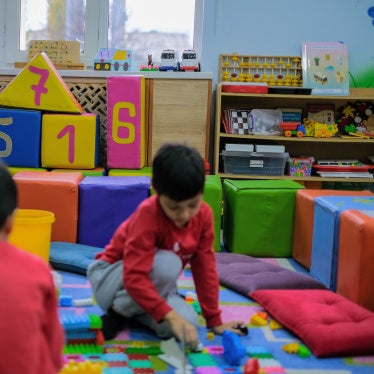All national armed forces and armed groups should reject using schools for military purposes during armed conflict, Human Rights Watch said today. On Universal Children’s Day, November 20, Human Rights Watch released a video in six languages on the impact of military use of schools on children.
In most countries with armed conflicts around the world, national armed forces or armed groups have used schools for military purposes, with devastating consequences for children and their right to education. Forces have converted schools into barracks, detention facilities, military training camps, weapons depots, and bases for military operations. Often, forces take over only part of a school, putting students attempting to continue their studies at grave risk.
“Schools should be filled with students, not soldiers,” said Bede Sheppard, deputy children’s rights director at Human Rights Watch. “When armed forces take over schools, they put children and their education in the line of fire.”
Children and teachers have been injured and killed, and schools destroyed or damaged, when forces have attacked schools because opposing forces were using them. Other consequences of the military use of schools include long-term school closures, declines in student attendance and enrollment, and psychosocial harm on students, teachers, and communities. Military use of schools has an especially negative effect on education for girls, who are at greater risk from the presence of armed troops.
Between 2005 and 2012, armed forces or armed groups have used schools in at least 24 countries in conflicts across Africa, Asia, Europe, the Middle East, and South America.
The video includes photos and footage obtained by Human Rights Watch researchers during their investigations, as well as by Magnum and Getty Images photographers working for Human Rights Watch.
The video contains archive footage of Malala Yousafzai, the teenager who was shot by the Taliban for advocating education for girls in Pakistan, inspecting a school that had been run by her father. The family discovered that it had been occupied and used by the Pakistan military during the Yousafzai family’s exile from the Swat Valley.
Students and educators who wish to add their voice to support the end of military use of schools can contribute photos and slogans to the website EMUScampaign.org.
Human Rights Watch is working with the inter-agency Global Coalition to Protect Education from Attack and expert partners and governments to develop new international guidelines to improve protections for schools and universities from military use. These are known as the Draft Lucens Guidelines for Protecting Schools and Universities from Military Use during Armed Conflict.
All countries should support the process of developing these guidelines, and endorse them once they are finalized in mid-2014, Human Rights Watch said. Countries around the world are also encouraged to enact laws and endorse policies to protect schools and to incorporate the guidelines into their military doctrine, manuals, and training.
“By next year’s Universal Children’s Day, countries should be stepping forward as champions for protecting children’s education by barring use of schools by their own armed forces,” Sheppard said. “It’s high time armies gave schools back to the students.”
The video is available in Dutch, English, French, German, Japanese, and Spanish. The video was produced by Human Rights Watch and the Global Coalition to Protect Education from Attack.






